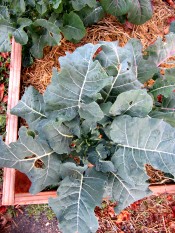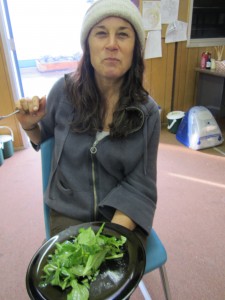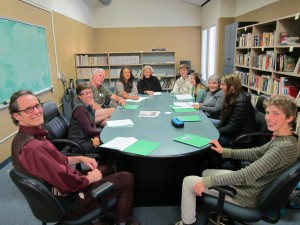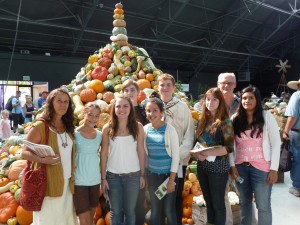Waldorf News
Sustaining Ourselves – Credo High School Explores Agricultural, Environmental & Economic Sustainability

By CHIP ROMER
The idea of sustainability was introduced early in Credo’s development by our advisor Betty Staley, director of Waldorf High School Teacher Education at Rudolf Steiner College. Betty’s recommendation was to align Credo’s mission with something unique and important to our geographical region. Initially, given Sonoma County’s progressive organic farming and the increasing prevalence of biodynamics, our alignment was with was sustainable agriculture. Quickly, the addition of sustainability as a core area of the school development provoked powerful, broadening discussions about the meaning of this ubiquitous term.
Living with increasing toxicity and under the daunting effects of climate change, Credo developers felt a moral imperative to teach students everything we could about environmental sustainability. As, during our development process, California edged out Mississippi as the state with the lowest funding for public education, we asked: how do we sustain ourselves economically? Delighted with the healthy social life that was emerging among our team, we wondered: how can we teach social sustainability? And, when one of our overextended team members worried that she couldn’t keep up with all of her responsibilities, we recognized we could hope to help our students avoid this too-familiar pattern and developed a goal to teach them about personal sustainability.
Led by Sustainability Manager Kirsty Shelton, the Credo development team built all of these qualities of sustainability into our mission statement: to complete the K-8 education of North Bay public Waldorf students by offering an exemplary, holistic, college preparatory public charter high school that is inspired by Waldorf education and committed to teaching and modeling 1. agricultural, 2. environmental, 3. economic, 4. social and 5. personal sustainability. Now that we are up and running, how are we doing this? Let us count the ways…
 Agricultural Sustainability
Agricultural Sustainability
All ninth graders take a hands-on intensive in Farming and Food Literacy. Taught by former professional organic farmer and experienced public school teacher Kelley McNeal, Credo’s farming students work hard amending the campus’ inhospitable adobe soil. “Gypsum—recycled drywall—can make adobe soil more fertile, which is a great lesson to our students,” McNeal explained. “We ordered a truckload of gypsum to amend the clay and now we’re planting vegetables. We’ve had a couple of giant salads, and by early spring our students should be eating regularly from the garden.”
Students in Credo’s Practical Skills class have built eight raised beds, which are now home to herbs, broccoli, broccoli rabe, cauliflower, carrots, garlic, onions, shallots, beets, spinach, kale, collards and chard. Students also fabricated a beehive, and a colony of bees is scheduled to move in this spring. A Plexiglas demonstration hive is also on the horizon for the Credo farming classroom. A colony of worms turn organic food scraps, shredded paper and paper towels into rich fertilizer for the Credo gardens. “We’re learning that waste from one process is the food for another,” said a Credo student
In addition to getting their hands dirty, Credo ninth graders also study Michael Pollan’s The Omnivore’s Dilemma for Kids—the Secrets Behind What You Eat, and the film Food, Inc. “These sources help students to connect the dots between the work that they do in the garden and the politics of food production,” said Education Director Thom Schaefer. “With over 16,000 organically farmed acres, Sonoma County is one of the most progressive food producing regions of the world. We want our students to appreciate this, to understand that the rest of the world is lagging behind, and some of the politics behind that.”
 Credo teaches tenth graders biodynamic farming, which recognizes the whole earth as a single, self-regulating, multi-dimensional ecosystem and intends that farms be run in a similar way, with emphasis on crop rotation, plantings timed with lunar cycles and special soil-improving compost teas and soil tinctures. Biodynamics and Credo’s Waldorf curriculum spring from the same creative source, philosopher Rudolf Steiner. “There is a natural affiliation between biodynamics and Waldorf education, and Sonoma County is among the most active world centers for both of these progressive movements,” Schaefer said.
Credo teaches tenth graders biodynamic farming, which recognizes the whole earth as a single, self-regulating, multi-dimensional ecosystem and intends that farms be run in a similar way, with emphasis on crop rotation, plantings timed with lunar cycles and special soil-improving compost teas and soil tinctures. Biodynamics and Credo’s Waldorf curriculum spring from the same creative source, philosopher Rudolf Steiner. “There is a natural affiliation between biodynamics and Waldorf education, and Sonoma County is among the most active world centers for both of these progressive movements,” Schaefer said.
“At Credo, we are preparing our students to become world leaders,” Credo Director Chip Romer explained. “Many of them could, as adults, be in a position to help solve issues of famine and hunger. Studying Farming and Food Literacy and Biodynamics introduces them to the skills and understanding that may get some of them started on that path. We’re planting that seed, if you will.”
Environmental Sustainability
Credo recently took a big step towards meeting its mission of “teaching and modeling environmental sustainability” by establishing a school Eco Council. Comprised of students, parents, teachers, an administrator and a community member, the council meets monthly to review Credo’s appropriate use of resources and to make recommendations concerning environmental sustainability to the faculty and board of directors.
Inspired by ideas proposed in Smart by Nature, a book about sustainable schools created by Berkeley’s Center for Ecoliteracy and by the Green Schools Initiative (www.greenschools.net), Credo’s Eco Council has already made serious strides in steering the school’s culture. During the ninth grade Environmental Science block, two field trips exploring responsible waste management—one to the landfill and another to the recycling center—quickly raised students’ consciousness about waste.
“At Credo, we no longer talk about ‘trash’ or ‘garbage,’” explained environmental educator and Eco Council community volunteer Marie-Josée LeBlanc. “Those words imply that that our waste is going vaguely away, when in fact, as the students saw, it is being plowed into the earth. On the Credo campus we have all but eliminated what are now labeled as ‘Landfill’ cans.”

In fact, only one “Landfill” can was visible during a recent visit to the campus, where all rooms have a recycling bin and a compost bin. The school is following a Reduce, Reuse, Recycle and Rot (compost) approach to waste management. “Students and staff are beginning to see that about ninety percent of the waste we generate at school is recyclable, and a lot of it, through composting, is put to good use right here in our own back yard,” said Eco Council student rep Kaylyn Conway.
Credo’s Eco Council is comprised of students, parents, teachers, and community members.
In partnership with energy supplier PG&E, Credo has recently replaced all campus mercury thermostats with new programmable ones that heat classrooms only during periods when class is in session, conserving energy and saving on the school’s utility bill. Practical Skills teacher Owen Massey-Todd made this a learning experience for students, demonstrating how the devices work.
Advised by the Eco Council, the Credo Board of Directors recently passed a Sustainability Resolution that guides administration to implement an environmental policy that:
• Eliminates the use of pesticides and herbicides
• Uses least-toxic cleaning materials
• Creates recycling and composting programs
• Prefers the procurement of recycled classroom and office supplies
• Bans sales of junk food and fast food
• Encourages development of a school garden
• Encourages development of garden-to-table lunch program
• Calls for developing a plan to ensure that any new campus construction uses environmentally sound building materials, makes efficient use of energy, water and other resources and creates a campus that is ultimately an independent power producer using clean renewable technologies such as solar and wind.
“Our students take their futures very seriously,” said Credo Education Director Thom Schaefer. “They have inherent wisdom about environmental matters, and are already fast at work taking responsibility for ensuring a healthy world. They are our great hope.”
Economic Sustainability
Funding for public education in California has dropped for many years, landing the golden state at the bottom of all fifty states in per-pupil spending. A public high school student in Sonoma County “earns” about $6,500 per year for her school from a combination of local property taxes and state funding. New Jersey ranks at the top in per-pupil funding, with an average of $9,500 per student, but individual districts spend as much as $28,000 per pupil in some places in New York and over $15,000 per pupil locally, in parts of Marin and Napa Counties with particularly high property tax revenues. Tuition at private high schools in the North Bay ranges from about $14,000 to well over $30,000—from double to over five times the state funding for public schools. So how can our public schools provide an education comparable to local private schools or to well-heeled public school cousins in pricier neighborhoods?
 This question was deeply studied by Credo High developers, who during the school’s planning years watched annual funding for public high school students in California drop by over $1,000 per year. “To provide a rigorous college prep education that qualifies all graduates for college and is rich in the arts and social-emotional development costs considerably more than the state ensures,” said Credo CFO Steve Bossio. “We have to change the way we talk about funding for public education in California. We have to help our parents, students, community members and philanthropists understand that public funding provides for only the barest minimum of educational quality. If we are going to truly educate young people to become creative leaders of the future, we need the help and collaboration of all stakeholders. Like it or not, our public schools need complementary private funding to be effective and competitive.”
This question was deeply studied by Credo High developers, who during the school’s planning years watched annual funding for public high school students in California drop by over $1,000 per year. “To provide a rigorous college prep education that qualifies all graduates for college and is rich in the arts and social-emotional development costs considerably more than the state ensures,” said Credo CFO Steve Bossio. “We have to change the way we talk about funding for public education in California. We have to help our parents, students, community members and philanthropists understand that public funding provides for only the barest minimum of educational quality. If we are going to truly educate young people to become creative leaders of the future, we need the help and collaboration of all stakeholders. Like it or not, our public schools need complementary private funding to be effective and competitive.”
Credo asks parents to support their children’s education with a voluntary monthly pledge to the school, and currently about 80% of families are able to make some kind of donation. In addition, Credo seeks grants from public and private sources and requests the support of individual philanthropists who value making Waldorf education available to all students, regardless of financial means.
Credo has also begun to consider how its students can help. “I was attending a Sustainable Industries Forum breakfast in San Francisco, when it struck me that our single biggest resource at Credo is our students,” said Credo Director Chip Romer. “We expect our graduates to become important leaders of the future in the cultural, economic and political realms, and we hope that they will have developed an ethic to support future leaders among the Credo students who follow behind them. Long-term, if we have served them well, our appreciative alumni will be our largest—and always growing—donor base.”
As part of its intention to prepare students for leadership roles, Credo is developing a curriculum that yields a core understanding of economic systems and builds competency about interacting with such systems through courses in financial literacy. All second-semester ninth graders take a social studies course in “History through Economics,” which compares different economic systems and their places in history. They also study “Financial Literacy,” which helps them understand how our current system works so that they can flourish in it—or change it to better reflect their own values.
“The freshman level of ‘Financial Literacy’ is introductory and very practical,” explained Romer, who majored in economics at the University of Notre Dame. “Students learn about job seeking—how to write a resume, a cover letter and how to interview. They study a pay stub and learn what all the categories of withholding mean, and they are presented with a variety of options about what to do with their take-home pay. Then the school leads students in starting three student-run model businesses: one is a hierarchical for-profit business; one is a worker-owned collective; and one is a non-profit. There are job postings, and students have to apply and interview for various positions; it is intended to be an involved role play where students have fun, get work experience and maybe even make money.
“By senior year, we hope to teach students how to prepare their own taxes and plan investment strategies. Before too long, these young people are going to be running our economy and managing our retirement funds.”
Credo has its work cut out for it. In a state that places rapidly diminishing value on funding public education, the charter school remains determined to support public school students in developing the understanding, skills and ethics to assume leadership positions in tomorrow’s economy. “We can’t afford not to teach students these things,” Romer said. He believes the school will continue to find private support to supplement public funding. “It’s in everyone’s best interest to help us demystify economics and develop students’ financial literacy in an age appropriate way as soon as possible. They hold the purse strings of our future, and we need them to be as well-prepared as possible.”
Learn more about Credo High School at credohigh.org.

 Immersive Academics and Arts
Immersive Academics and Arts Bringing Love to Learning for a Lifetime
Bringing Love to Learning for a Lifetime Everything a Teacher Needs
Everything a Teacher Needs Great books for Waldorf Teachers & Families
Great books for Waldorf Teachers & Families Waldorf-inspired Homeschool Curriculum
Waldorf-inspired Homeschool Curriculum Roadmap to Literacy Books & Courses
Roadmap to Literacy Books & Courses The Journey is Everything
The Journey is Everything Association for a Healing Education
Association for a Healing Education Train to Teach in Seattle
Train to Teach in Seattle Waldorf Training in Australia
Waldorf Training in Australia Bay Area Teacher Training
Bay Area Teacher Training ~ Ensoul Your World With Color ~
~ Ensoul Your World With Color ~ Transforming Voices Worldwide
Transforming Voices Worldwide Quality Education in the Heartland
Quality Education in the Heartland Jamie York Books, Resources, Workshops
Jamie York Books, Resources, Workshops Summer Programs - Culminating Class Trips
Summer Programs - Culminating Class Trips Full-Time Teacher Education
Full-Time Teacher Education Flexible preparation for your new grade
Flexible preparation for your new grade Caring for All Stages of Life
Caring for All Stages of Life Middle School Science With Roberto Trostli
Middle School Science With Roberto Trostli Space speaks. Its language is movement.
Space speaks. Its language is movement. Apply Today: New Cohort Starts Nov. 2025
Apply Today: New Cohort Starts Nov. 2025 RSS Feeds
RSS Feeds